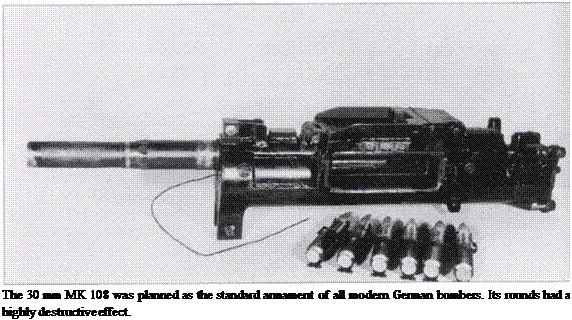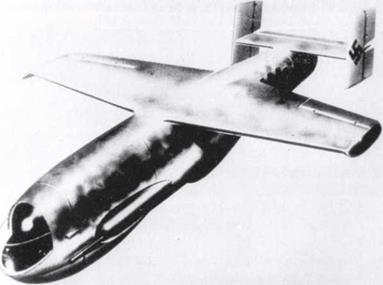Heinkel P1077Julia
The Julia project was developed by Heinkel-Siid Vienna under the designation He P 1068. Initially, as with the Natter, the pilot was to fly the aircraft from the recumbent position and take-off vertically. Experiments with scale models in 1944 had shown the general feasibility of a vertical start for small rocket fighters. Julia was devised by engineers Wilhelm Benz and Dr Gerloff in the spring of 1944. On 19 August 1944 they presented their provisional drawings. The development of the first experimental specimen designated He P 1068 was scheduled for completion within six to eight weeks based on a detailed proposal from Benz on 8 September 1944. Heinkel-Siid s research division, recently resettled at Neuhaus an der Triesting, was headed by engineer Jost. Some of the technical calculations were done by Professor Schrenk and engineer Kottner of the Technical University of Vienna. Work progressed slower than hoped because
of technical problems, although at the beginning of September 1944 the RLM placed a definite order for 20 prototypes.
The contract for a series run of300 machines followed on 22 September 1944 under the designation He P 1077, the various component parts being farmed out to diverse firms so that Heinkel could devote itself to the Volksjager. On 15 October 1944 Heinkel-Siid announced a Julia variant, a local midget fighter propelled by a Walter HWK rocket motor with four solid-fuel rockets as take-off boosters. The pilot steered sitting up. Heinkel also had a ramjet version, Romeo.
A number of ideas were tested exhaustively for the Julia take-off, from a vertical start using a disposable undercarriage to a launch trailer similar to that used to fire the Enzian flak rocket. After the visit of Director Robert Liisser to Heinkel Vienna on 26 October 1944, proposals were put forward to modify Julia in line with Natter. These envisaged a new outline, a change to the tailplane and the pilot sitting upright, which ruled out the vertical take-off. Reworking the design cost valuable time and in October 1944 the first wooden mock-up of Julia was destroyed in an Allied air raid on Vienna.
On 12 November 1944 Heinkel tested the first one-eighth scale model of Julia in the large DVL wind tunnel. All the data for the project were now assembled and on 16 November 1944 the files were sent to the Chief-TLR.
|
The Heinkel He P 1077, here a computer graphic, was to have been built in the St Polten-Krems-Vienna area. None were produced because of the He 162 priority programme. |
Ernst Heinkel was hoping at the beginning of December that no more than the original 20 prototypes would be requested. The first five of these were to be manufactured by Potzel, the remainder at smaller factories. The NSFK in Vienna was to handle the final assembly work.
During the development conference on 21 and 22 November 1944 it was agreed that all project studies for local-defence fighters had to be subject to the usual priorities. Especially important to the Chief-TLR was the development of the Me 262 with one or two additional rocket motors. The building and trials of Julia took second place to this. Third came the further development of the Me 163 while the Ju 248 was downgraded because it was more expensive than the others to build. The Bachem BP 20 Natter was in fourth place at the end of November 1944.
On 28 November 1944 a comprehensive project portfolio was sent to Professor Hertel of the EHK. The files showed a pressurised cockpit allowing ascents to 15,000 metres (49,000 ft). Armament would be either two MK 108s with 40 rounds each or a Fohn battery with Marz automatic target-seeking equipment. The cockpit capsule weighed 60 kg. The fuel tanks were unprotected, and being of aluminium had no surrounding layer of rubber. Engineer Jost planned to use the approved 109-509 fuel mixture. A radio unit was considered unnecessary because the aircraft would operate locally to its ground base and the target.

Between 27 November and 19 December the wing drag forces and various load effects were worked out and the polar and resistance coefficient calculations
begun./w//# was wind-tunnel tested at AVA from 5 December 1944. There seem to have been no major problems, and the blueprints for prototypes V-l and V-2 were completed on 13 December 1944 so that Heinkel could forecast delivery of the first machine for 24 January. By 20 December 1944, despite the immense problems, Heinkel-Slid had succeeded not only in completing the development material for the He 162 and producing prototypes, but was close to completing the development of Julia too.
On 22 December the EH К recommended the Chief-TLR to suspend all work on Julia and Natter and to concentrate effort into developing the Me 262 with additional propulsion, and the Me 263. The Commission believed that the risks inherent in the envisaged speeds for machines built of mixed construction methods were too great. On 5 January 1945 Heinkel-Siid was ordered to stop work on Julia. At the time a model made by the Schaffer company at Linz was being tested by the SS-LFA at the Braunschweig wind tunnel. In the hope of keeping the door open, Heinkel-Siid approached the Chief-TLR on 27 January, pointing out that besides two versions to be tested as gliders, the next two would have rocket motors. General-Engineer Lucht came back within four days repeating the OKL instruction that the entire project be abandoned and the mock-up room at Neigaus closed down. All staff, especially the carpenters and joiners, were to work forthwith building the He 162 trainer.
It seems that Heinkel ignored him and allowed the work on Julia at the subcontracted firms to continue. At Wiener Metallwerken a 1:4 scale model of Julia was completed at the end of January. Near St Polten several acute-angle starts were made using rocket-propelled models. The three full-size prototypes built by Schaffer of Linz in January were scheduled for transport to Karlshagen for trials if possible by 20 February. However, the test centre there was wound up in March, and it is doubtful if the tests were made.
On 14 February 1945 Dr Heinkel mentioned during a conference that he had received the order of the Chief-TLR to suspend ah work on Julia but he had pressed ahead. This came to the ears of the Chief-TLR two days later, and a new instruction then arrived at Heinkel-Siid leading to an agreement to limit production to four Julia of which two would be rocket-propelled. On 17 February 1945 Heinkel took the unilateral decision to begin steep-angle launches of the full-size aircraft.
Although the order to suspend all work on Julia was repeated on 21 February, the Chief-TLR allowed the Geppert company at Krems/Danube to begin assembly work on two unpowered Julia (MZ) at the beginning of March. Shortly before the war’s end the machines were completed by Dr Gerloff after being signed off, but whether they were flight-tested with solid-fuel rockets is doubtful.
On 3 March the Heinkel-Siid technical management decided that the Julia test machine should be completed and delivered ‘as per contract’. The two rocket – powered machines (M4) were to be assembled by Schaffer of Linz without delay. The serviceable aircraft were destroyed by forced labourers upon the approach of US forces, however, and Russian troops at Triesting seized most of the Julia documentation for further assessment.











